Sensation & Perception
1/68
There's no tags or description
Looks like no tags are added yet.
Name | Mastery | Learn | Test | Matching | Spaced |
|---|
No study sessions yet.
69 Terms
Perception
are brain seeing something & trying to understand the information
Sensation
all of us are picking up the same light waves
Sensation VS Perception
➔ Sensation: Raw data is processed by sensory receptors – eyes, ears, nose, skin, tongue
◆ Process of receiving, converting, transmitting info from the internal & external environment onto the brain
◆ Receptors detect specializes stimulus & convert to neural impulses that are sent to the brain
Perception: active creative processes
◆ selecting , organizing, interpreting sensory info
◆ Sensations are processed in the brain
◆ Different people will perceive the same stimulus in different ways
● Even in the same person, surrounding context & other info can impact how something is perceived
What are the 3 types of Processing?
Process 1.
Transduction : convert sensory stimuli into neural impulses that are sent to the brain
-The brain doesn’t interpret light waves, it uses neural impulses, action potentials, that is how different parts of the brain communicate with each other,
- Must be converted form of energy into another; sensory stimulus into neural impulses; Sound waves into action potentials
What is Sensation Process number 2?
2. Sensory Reduction - filter & analyze incoming sensations before sending neural impulses on to the brain
- So many stimulus, occurring all the time, and this is too much on the brain.
- There is a filtration that occurs before neural impulses are sent to the brain or else it would bombard the brain and make it difficult to know what to focus on
What is Sensation Process number 3?
Coding - neural impulses travel by different routes to different parts of the brain, allowing us to detect physical stimuli as distinct sensations
How to measure Sensitivity? (3 ways)
Psychophysics
The study of the direct relationship between physical properties, stimuli and psychological experience of them
- We are only consciously aware of a set of stimuli at a time
Detection
When you notice that the stimulus is present
-How do we measure whether or not you’ve detected a stimulus?
Subliminal Stimuli
Anything we can’t perceive at least 50% of the time, t is technically & objectively present, but the person can’t detect it yet
Discrimination
How do we measure whether you can tell the difference between two stimuli?
Difference Threshold (Just Noticebale Difference)
- when you notice that there is a difference between the sound, or brightness of the light
● E.g. you might know that there is volume but you can’t make out what the TV is saying so you may increase the volume,
● You might turn it up one and will not notice a difference it sounds the same (lacking discrimination), ● when you notice a difference then that is when you have reached a difference threshold - when you can now perceive that the volume has increased.
Weakening Sensitivity
Sensory Adaptation
Diminished sensitivity as a consequence of constant stimulation
- Receptors fire less frequently in response to repetition
- Sensory receptors are alert to things that are new and different
- When exposed to the same thing constantly firing happens less frequently
● Info does not go to the brain
● E.g. smoking, he doesn’t think he smells like smoke, but it is because he cant smell the smoke on himself anymore because of the constant exposure, and so the stimulus wasn’t firing
● E.g. the clothes you are wearing ; it would be problematic if they kept firing to the brain to tell it to keep on sensing the clothes
Two types of stimuli that we never adapt to
1. Visual - eyes are always moving, and receptors are gaining slightly different new info so they continue to fire
2. Extremely intense stimulation - such as pain, neurons will continue to fire if you broke your le
Vision: Sensation
Electromagnetic Spectrum
Light is a form of electromagnetic energy that moves in waves ➔ Many waves that exist on the spectrum; only a small part is visible to humans
- Runs from 400nm (blue violet) to 700nm (red)
Light Energy
a) Wavelength -distance between one peak to the next peak
◆ Greater the distance the less often the wave is peaking
● The less often it peaks the lower the frequency
b) Frequency of peaking determines the color/hue we see
-High frequency, short wavelength, = violet color
- Low frequency, longer wavelength = red color
c) Amplitude = the height of the peak
- Greater amplitude = brighter color
- Smaller amplitude = duller color
The Eye
Position of the Eye
Predators have two eyes at the front , providing the brain overlapping
views, each eye gives a slightly different image which overlap & will allow
us to perceive depth & target where the prey is
◆ Prey have eyes at the side of the head, independent views from each eye,
so they have a wider field of vision allowing them to spot predators, find
paths of safety
Parts of the Human Eye
Pupil
~ black part in the center, an adjustable opening that can dilate or
constrict to allow different amounts of light into the eye
- Size of pupil controlled by muscles in iris
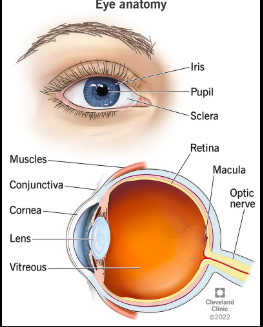
Iris
coloured band around the pupil
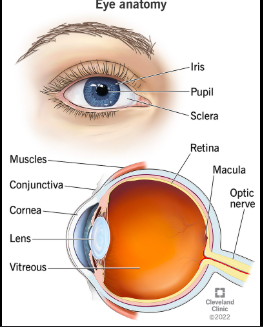
Sclera
~ white outermost layer of eye
- Completely opaque except for right infront of the pupil and iris, it bulges out a bit
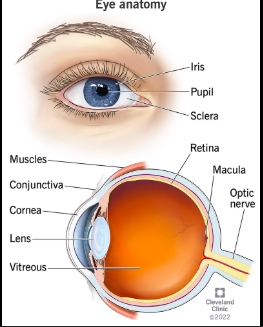
Cornea
~ transparent portion of sclera on top of the pupil & iris
● Bend/refract light as it enters the eye
● Photons enter the eye and they need to be focused on the back of
the eye so to do this cornea bends it to provide focus
○ Simple but messy way to direct light
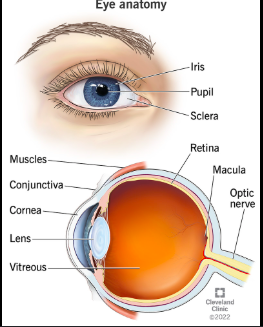
Lens
behind pupil helps focus light rays
Known as accommodation – ciliary muscles on either side of the lens
will alter curvature and thickness to focus/fine tune the light
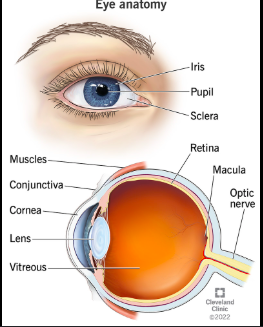
Retina
~ back of the eye, image lands here,
● contains photosensitive cells, photoreceptors and this is where visinos begins
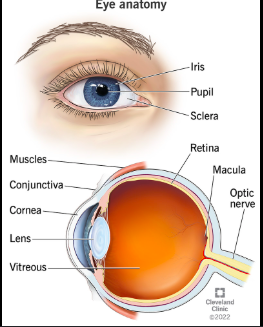
Fovea
~ indent near centre of retina,
● Comprised of cones
● Place where objects are seen the best - greatest visual affinity
● Most sensitive part nothing to block light coming in
● Associated with seeing fine detail in an object
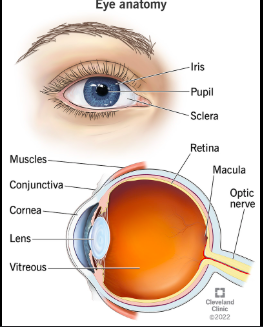
Optic Nerve
dense collecitoin of axons from cells of retina that come together and exit the eye at one spot so visual input can go to the brain for processing
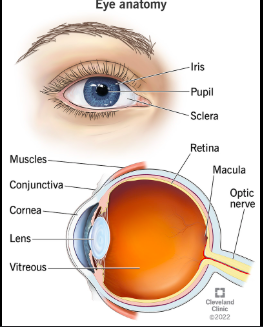
Retinal Image
Analogy: Eye is like a camera (focus with real lens, film, get it developed
Lens & Cornea to refract and focus the light
Film(retina) to capture image and send it for further processing
How the eyes work
1. Light rays move into eye, cornea bends/refracts light
2. Moves into lens and here fine tuning to refraction is done to focus on things that are closer/farther away
3. When ciliary muscles are relaxed lens is flat ; focused on point further away
4. When ciliary muscles constrict lens becomes curved; focused on point closer
Myopia {Nearsightedness)
you can see things that are closer better
Presbyopia {farsightedness}
can see things better further away
The Retina
Made up of photoreceptors - photosensitive cells on the back of the eye (where vision starts)
Cones
a. 6 million in each eye, less cones than rods
b. Responsible for colour vision & fine detail, visual acuity
c. Most sensitive to bright light conditions (e.g. day time)
d. Prevalent on the middle of the retina (almost exclusively on the
fovea)
e. Animals that are only active during the day (e.g. chipmunks, pigeons)
only have cones, cause thats all they need
2. Rods
a. Responsible for dim light viewing (night vision)
b. More prevalent on the periphery, outsides of the retina
c. More plentiful 120 million/ eye
d. Most active in dim light, night e. No colour sensation
f. associated with low visual activity (hard to get detail in the dark)
g. Produce black, grey, white vision
Why don’t we have more cones, if they have more detail & see color?
Cones provide lots of info to the brain so if the whole retina was densely
condensed with them we would need a huge brain to process all of this info
Eye Movements
➔ You might feel that you are getting an image in one snapshot, seeing the whole
thing at once
➔ But measuring eye movements shows that, our eyes move all around the picture to
get a sense of the entire image
➔ The brain puts together the sensory info to make us feel as if we got it at once
➔ This shows why it is difficult to separate sensation & perception
➔ Because as info/light waves enter the eye the brain starts to process that info
based on previous experiences, knowledges & other images that its receiving
➔ So seamless we don’t notice our eyes moving
Blind Spots
Blind Spots
➔ At fovea no other cells covering the cones allowing for clearest vision
➔ Optic nerve however has no photoreceptors
◆ Blood vessels, retinal ganglion cells are exiting the eye
◆ Giant tunnel where info is moving through
➔ Why don’t we notice we have a blind spot?
◆ Because we have 2 eyes
◆ Each presents slightly different views of the world
◆ Your brain will make up the gaps
◆ You dont have a giant black spot when you close one eye, because secretly
your eyes are moving
◆ You are getting 2 images that are being put together by the brain, it will fill
in gaps from one eye that are falling on the optic nerve on the blind spot of
the retina
◆ Eye movements makes slight adjustments that are being processed by the
brain
◆ Moving eyes around gives brain info to seamlessly perceive an image
To find your blind spot you have to use one eye, no longer seeing the parro
Colour Vision
➔ Competing theories about how colour vision occurs
➔ Young-Helmholtz Trichromatic Theory
◆ Colour perception results from three types of colour receptions in the retina
● Comes from the 3 types of cones
◆ Red, Green, Blue
◆ Other colours are formed through a mixture of these colours
◆ When cones are stimulated in combination it produces a spectrum of colour
◆ What matters it the ratio of activity among the 3 cones producing spectrum
Opponent- Process Theory
◆ Colour perception is based on 3 systems, each of which contains 2 colour
opposites
◆ Red-green, Blue-yellow, Black-white
◆ Neurons in the retina, thalamus will be turned on by one of these in the
colour opposite & turned off by the opposite
● Each receptor will respond to either red or green not both
● This explains color acroniges
● American flag- receptors are getting fatigued
○ And so the other receptor works
Both of these theories are correct!
◆ Processing occurs in 2 stages
◆ In the retina it is Trichromatic, differential responses of three different cones
◆ Then the cones responses are opponent process as it moves on to the brain
optic nerve etc
1) Selection
➔ The brain actively listens & sees so it can’t get everything that is senses
➔ We will focus on something and ignore others
Selective Attention
◆ Filtering out & consciously attending only to important sensory messages
◆ E.g. at a party, you can still have a convo with the person next to you
despite the loud background noise
◆ Cocktail party effect: when having a discussion with someone and suddenly
we hear our name said by someone else in a different name, this suggests
that the brain has underlying processing of incoming information, the brain
takes it in but chooses to ignore unless it is important (e.g. our name)
Feature Detectors
Nerve cells in the brain’s visual cortex that respond to specific features of
the stimulus
◆ E.g. nerve cells in brain that only respond to movement, only to faces,
◆ Animals also have feature detectors (e.g. cats have vertical & horizontal
presentations, frogs have fly detectors)
Habituation
-The brain’s reduced responsiveness due to repeated stimulation of the same receptors
-Brain is not going to respond to stimulation
- Studies with young children, use habituation paradigm, stimulus is presented to child several times, ba ba ba ba then change it slightly to see if they noticed ba ba ba da ba da da , did they dishabituate & regain attention
2) Perceptual Organization
➔ We engage in parallel processing, the brain divides a visual scene into multiple
parts, motion form, depth color etc
We organize sensory information in terms of:
◆ Form
◆ Constancy
◆ Depth
◆ Colour
➔ Organization: the way we put/identify patterns to understand the world
Organization: Perceiving Form
➔ Organization occurs in the mind not the retina
◆ Top-down processing: use prior knowledge, experience, expectations to
construct perception; higher level mental processes that will be used in an
active creative way
◆ Bottom-up processing: begins with sensory receptors and works up to brain
integrating all these processes together, combines elements of the stimulus
(lines, shading, colour) allowing us to form unified perception of the objec
➔ Gestalt Laws of Perception
◆ Gestalt means form or whole
◆ Basic principle: elements within a pattern don’t operate independently
● The whole is more than the sum of its parts
● Eggs, flour, sugar, what comes out is a whole something different
new you can’t taste the individual parts
Figure Ground Principle (organization)
➔ Try to differentiate between the figure & the background
➔ Background is seen as further away
➔ See contours when there is distinctness in colour & brightness
➔ 2D image but brain perceives objects infront of each oth
More Laws of Organization
➔ Proximity: objects that are close together are grouped together (line of circles)
➔ Similarity: objects that are alike are grouped together (line of circles and squares)
➔ Continuity: link objects in ways that make sense to us, (long dog)
➔ Violation: when the object isn’t how we perceive it (sticks bent weird)
➔ Closure: when presented with open figures we fill in the gaps to complete it []
➔ Subjective contours: fake non existent triangle
Depth Perception
➔ We can see objects in 3D even though images that strike retina are 2D
➔ Monocular Cues (only needs one eye)
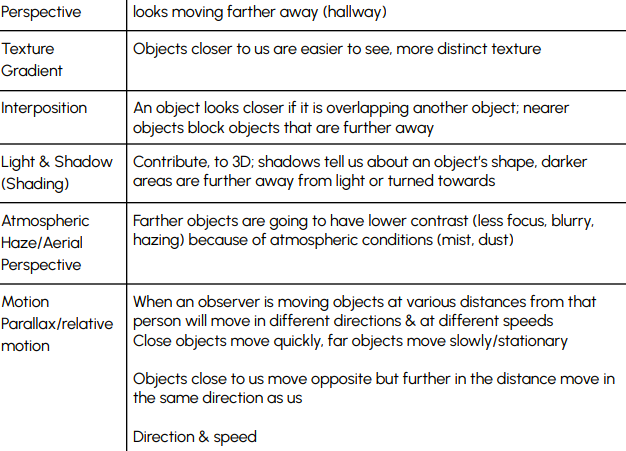

Hearing
➔ Sound waves interacting with structures of the ear
➔ Frequency: how often wave peaks, tells us about pitch (hz)
◆ More peaks higher pitch
➔ Amplitude: height of peak, loudness of sound
◆ Taller amplitude louder sounds
Anatomy of the Ear
➔ 3 sections: outer ear, middle ear, inner ear
➔ Outer & Middle ear are air filled, Inner ear is fluid fillled
➔ Outer Ear
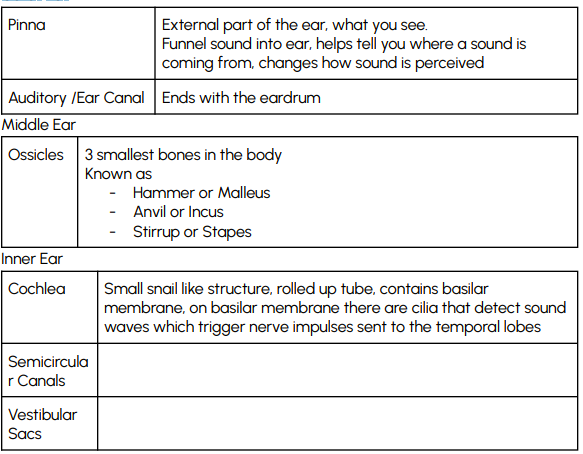
Auditory Transduction
➔ At the pinna sound waves are channeled into auditory canal
➔ Vibrates the eardrum (tympanic membrane)
➔ Vibrations of the eardrum will strike the ossicles (hammer, anvil, stirrup)
➔ Vibration of the ossicles will amplify the sound waves (more than 30 times)
➔ Stirrup will hit oval window setting cochlea’s fluid in motion
➔ Fluid waves move the hair cells (cilia) receptors on the basilar membrane
➔ Triggers release of nerve impulses to auditory nerve to the auditory cortex of the
temporal lobe
Why Two Ears?
➔ Helps determine where the sound came from (in two ways)
1. Timing (time of arrival)
● Noise coming from side will hit one ear before the other
● Difference in timing between ears will help determine location
2. Intensity
● Sound shadows (dampening of sound waves by the head)
● Sound passing through head on the way to other ear
Perceiving Pitch
Place Theory (place coding)
◆ Different frequencies stimulate different areas on the cochlea’s basilar
membrane
● Brain determines pitch by where on the membrane was generating
the neural impulse
● High frequency results in large vibrations in the beginning of the
cochlea
● Problem comes with low frequencies, vibrations are not in one
specific place (tend to involve vibration of more of the membrane),
the brain can’t pick up the frequency when most of the membrane is
involved so next theory
Frequency Theory (temporal coding)
◆ Different frequencies cause different rates of neural firing
● Brain monitors frequency of neural impulses traveling up auditory
nerve
● Hair in basilar membrane fires at the same rate of the sound
frequency
● Problem: there is a max # of times a neuron can fire in a second
(1000)
○ But we can hear frequencies higher than 1000htz?
○ How does this work? ….
○ Volley Principle: take turns firing so when they alternate each
doing combined frequency is what the brain interprets
BOTH!
Depends on frequency of the sound
◆ Low frequencies/pitch - less than 500 htz Frequency Theory
◆ High frequencies/pitch - Place theory
◆ Intermediate frequency - between 500 - 4000 htz both apply
Hearing Loss
Conduction Hearing Loss (Conduction Deafness)
Caused by damage to the mechanical system that conducts sound waves to the cochlea\
(damage to pina, tympanic membrane of eardrum, ossicles)
-Aka damage to anything before the Cochlea
- Have difficulty transferring sound waves to inner ear
- Hearing aids - amplify sound waves
Sensorineural Hearing Loss (Nerve Deafness)
◆ Caused by damage to the cochlea’s receptor cells or the auditory nerve
◆ Effects Inner ear (hair receptors, cochlea, auditory nerve)
◆ Could be due to aging, continual exposure to loud noise
● External cochlea - if problem is with cochlea in particular
○ auditory nerve has to be intact for this to work
○ Ideally have a brain that learned to process sound before
adulthood (use it or lose it)
◆ Implanted in childhood or they were able to hear &
then had damage
Body Position & Movement
Kinesthesia
system for sensing the position & movement of individual body parts
Vestibular Sense
sense of body movement & position that enables balance
◆ Centered in head (inner ear, semicircular canals & vestibular sacs)
◆ Balance sense
◆ Body posture
◆ Monitors head’s position & movement
◆ When head moves, hair like receptors are stimulated sending nerve
impulses to the cerebellum for interpretation
◆ E..g spinning around, fluids in inner ear won’t return to neutral state
immediately and that’s why you feel dizzy, even tho you are standing still
fluid is still moving
Interactions
Sensory Interaction
principle that one sense may influence another
◆ McGurk Effect, Ba Ba Ba, Fa, Fa, Fa,)
◆ Two senses provide different info
◆ What we sees overpowers what we hear
◆ Senses don’t operate independently, what you see influences what you
perceive that you hear
Embodied Cognition
- influence of bodily sensations, gestures & other states on
cognitive preferences & judgements
◆ Interaction between physical sensations and our thoughts & feelings, etc.
◆ E.g. sitting at a wobbly desk, you tend to feel your relationships with people
are not stable
● How your body feels impacts how you perceive how you prefer, rate
other things in the environment